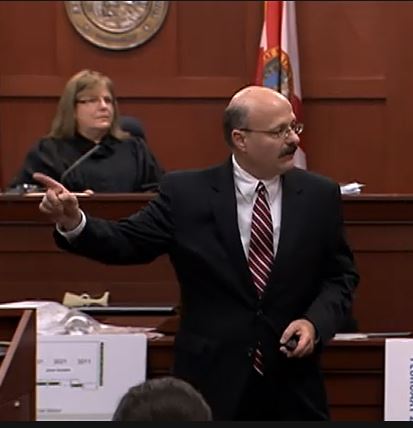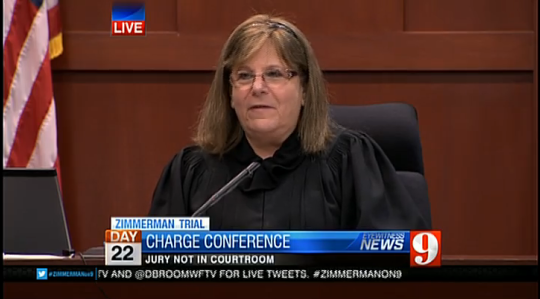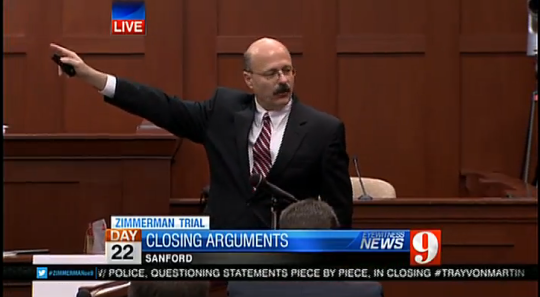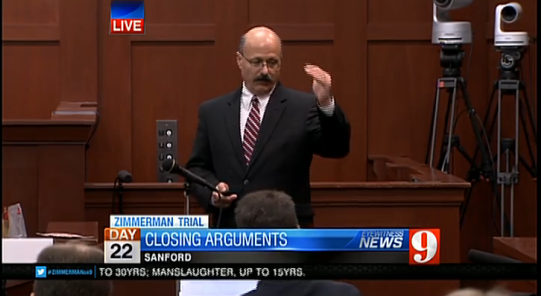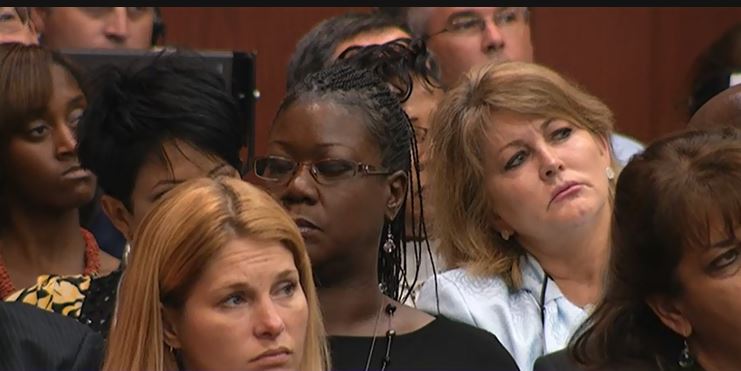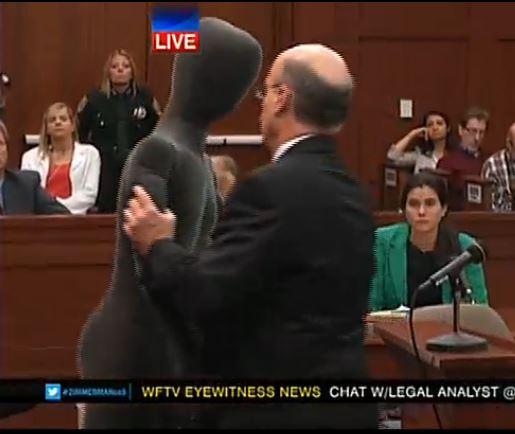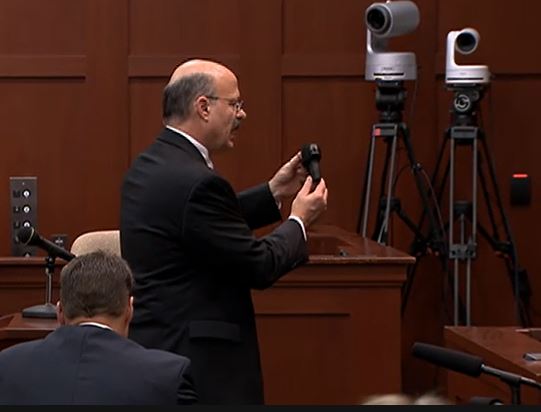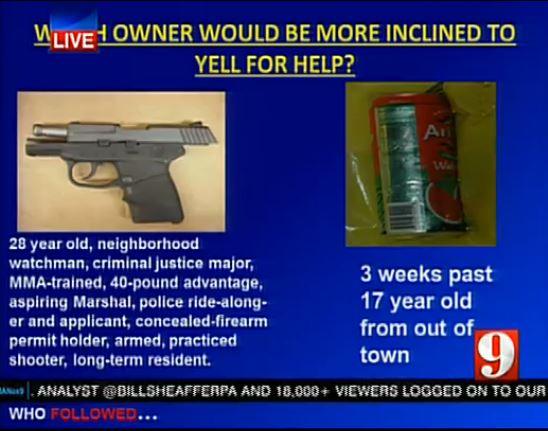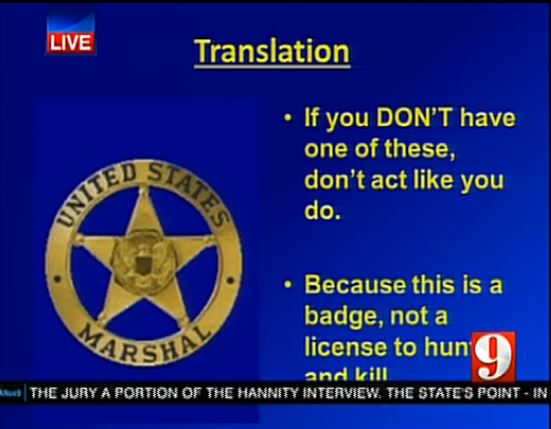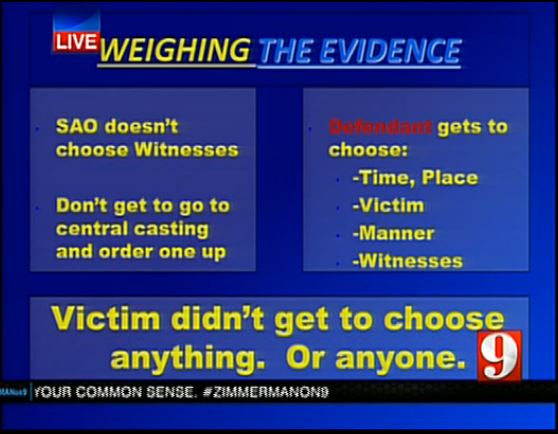NOTE: Streaming video of the entirety of the State’s closing argument is provided at the bottom of this post.
Today, the State presented their closing argument to the jury in the matter of Florida v. Zimmerman. After 14 months of investigation and discovery, weeks of pre-trial hearings, weeks more of trial testimony, and the expenditure of taxpayer money on the order of a million dollars, this was it–this is where the State would close the deal and deliver their compelling narrative of guilt to the jury.
What the jury got was not a compelling narrative of guilt, however, but a rambling monologue of isolated bits of circumstantial evidence, much of which was consistent with–and even supportive of–the defense’s “self-defense” theory of the case.
When I took my first serious look at this case, some six or so months ago, and worked though the existing discovery file, I thought to myself, the State’s got nothing. But discovery wasn’t complete, perhaps there was critical evidence not yet out.
When the pre-trial Frye hearings took place and the State presented their inept expert witnesses, I thought, the State’s got nothing. Judge Nelson agreed, and disallowed their testimony.
When I heard the State’s opening statements, and heard them describe the “facts” they said they would prove–knowing, with discovery effectively concluded, that there existed no evidence to support those representations–I thought to myself, the State’s got nothing.
When the State rested its case, and a few days later the defense did the same, and still there was nowhere to be seen a coherent, compelling, fact-based narrative of guilt–much less one supported by evidence beyond a reasonable doubt, I thought to myself, the State’s got nothing.
And this morning, when the State made their bizarre and desperate reach for murder 3 based on child abuse–properly denied by Judge Nelson–I thought to myself, that’s the act of a State prosecution team that’s got nothing.
This afternoon, throughout a couple of hours of closing argument by the lead attorney on the State prosecution team, Bernie de la Rionda, the truth was finally as concrete and undeniable as a sidewalk to the head–the State has nothing.
This afternoon I heard what was perhaps the most disjointed, fact-free, histrionic, and ineffective closing argument that I’ve heard delivered by a State prosecutor in a murder case in more than two decades of practicing law.
Maybe later I’ll tell you what I really think about it.
Regardless, we pride ourselves on being fact-based and giving all of you access to the raw information to come to your own conclusions–so let’s get to it.
A Slow Start
Bernie de la Rionda (henceforth “BDLR”) began his opening with a rather remarkably weak opening, stating that “a teenager is dead through no fault of his own, because another man made assumptions.” This does not strike one as particularly consistent with the evidence–the State’s own witnesses have Martin confronting Zimmerman, not the reverse, and surely no reasonable jury is going to believe that Zimmerman caused his own injuries. To say that Martin bears no fault seems simply incredible. Further, to my knowledge no one has ever died yet because a casual observer made some assumptions about him.
Odd Missteps: Vague and Aimless
Then BDLR made the first of many apparent “slips” in his closing, by referring to Martin as “a 17-year-old man.” Given the 12-year-old photos of Martin that had been strewn throughout society, and particularly the murder-3-based-on-felony-child-abuse the State sought only hours before, surely he could not have meant to refer to Martin as a “man”? Sure enough, one could almost see BDLR consciously remind himself to use “boy” rather than “man”, and sometimes first using the latter only to immediately correct and repeat the same sentence using the former. He might as well have held up a sign saying, “I am trying to mislead you into sympathy for the victim.”
As vague as that opening was, things only got vaguer. Next BDLR argued that Zimmerman’s “matter-of-fact” attitude after the shooting was indicative of . . . well, he didn’t say exactly, here merely said that “those actions speak volumes.” Volumes of what? Especially as the State’s own witnesses under cross had agreed that Zimmerman appeared to be in shock, not a state of casual indifference at having taken another person’s life.
Recounting of Zimmerman’s “Good Neighborliness”
Then BDLR sought to cast the net of causation to include events months before the shooting. He plays audio recording of Officer Singleton interviewing Zimmerman in which Zimmerman describes how the neighborhood had been experiencing a lot of crime, how his wife had become frightened, and how he’d started a Neighborhood Watch initiative to address the problem. How this was supposed to contribute to Zimmerman being guilty beyond a doubt of second degree murder was unclear.
Modest Variations in Zimmerman’s Accounts Held Out As Lies
He then began pointing out slight variations in statements Zimmerman had made at intervals of weeks or months, suggesting that these represented “lies”, and that these lies ought therefore to lead the jury to conclude that Zimmerman was guilty of second degree murder. In some cases the alleged “lies” were abjectly not lies–such as the fact that on one day Zimmerman claimed not to know an address, but after shooting a man in self-defense and having the location of the shooting become an important investigatory issue, he “suddenly” knew the address. Well, of course.
Zimmerman’s Profiling, and Skittles as a Motive for Murder
BDLR then argued that Zimmerman had “profiled” Martin as a criminal–surely true, at least in the context of potential, as it was the rationale for Zimmerman having called the police in the first place. He then went on to claim that Martin’s only “crime” had been the purchase of skittles and a fruit drink, and wearing a hoodie. It struck me that if I had been sequestered among 5 other jurors away from home, family, and work for some weeks, only to be told at closing argument that the Skittles and fruit drink were in any way a relevant issue in this case, I’d be rather unhappy. Even had Zimmerman been some kind of monstrous “Skittles killer,” there was no evidence whatever that he had any idea that Martin possessed the candy.
The Return of Rachel Jeantel: The “Tracking” and “Trapping” of Martin
Next up for discussion was Rachel Jeantel. I know my first memories of this witness was her obstreperous testimony, the sighs and eye rolling, the “that’s retarded, sir,” the “creepy-ass cracker”, the seeming refusal to speak at a normal volume that required constant repetitions of questions and answers, her remarkable facility for remembering dates–even as long as a year prior–favorable to the State, but unable to remember dates only days or weeks earlier favorable to the defense. And, of course, her perjury and many casual lies. Perhaps the jurors’ recollections were more favorable.
He used Jeantel’s testimony to argue that Zimmerman had not only “profiled” Martin, but had “tracked” him, as one might track an animal, and ultimately “trapped” Martin. Zimmerman, BDLR speculated–for there is absolutely no evidence for the proposition–“was gonna be what he wanted to be, a police officer.”
Martin as Fearful Victim Intent on Escape, Safety
Who was more scared, BDLR asked, Zimmerman or the “kid” being followed by a man in a truck? After all, he continued, it’s not like some guy [Martin] just came out of the dark and started beating Zimmerman up.” Except, of course, that the jury had seen extensive testimony–almost all of it provided by the State!–that this was exactly what Zimmerman said happened.
Zimmerman’s Perfectly Law Abiding Actions Preceding the Fight
Then BDLR transitions to an exposition of Zimmerman’s various actions in the minutes leading up to the attack and shooting. Oddly, he notes at each one that there is nothing illegal about this particular step, nor that one, yet somehow we are to conclude that they collectively evidence second degree murder. Seeing Martin and thinking suspicious? Not a crime. Calling police to report? Not a crime. Getting out of car? Not a crime. Zimmerman was armed, had a license, still no violation of the law, he said.
Mocking the Notion that Martin Was Armed With Fists and Sidewalk
Then he noted the apparent disparity in size of the two men–the athletic, fit Martin and the clinically obese Zimmerman, and noted that while Zimmerman was armed, Martin was armed only with Skittles. The defense will tell you, he said, that Martin was armed with his fists and concrete, and mocked the suggestion. But could he really believe that the jury that was time and time again shown the bloody and broken pictures of Zimmerman, who heard his physician’s assistant, Dr. Maio, and others testify to the dangerousness of head injuries, would buy into the notion that Martin was essentially harmless and armed only with candy? They’ve been sequestered for weeks to have that argument presented to them? Really?
“These A-holes” and “F’ing Punks”
Inevitably we got into perhaps the only portion of the evidence remaining that could possibly be referred to as the “meat” of the State’s theory of the case–Zimmerman’s utterances of “these assholes” and “fucking punks.” Curiously, BDLR conceded upfront that Zimmerman had not been shouting these words, as the State had sometimes done during the trial–and which BDLR himself would be doing shortly, and repetitively at the top of his lungs during his closing. Indeed, BDLR argued now, the very fact that Zimmerman muttered the words was indicative of ill-will and hatred.
Zimmerman Must Be Held Accountable For His–Lawful?–Actions
At that point BDLR transitioned to a talking point one usually hears at the end of a prosecutors closing argument–that the defendant should be held accountable for his actions, and that he was asking the jury to do just that–hold Zimmerman accountable.
The timing of this statement was truly bizarre, however, because up to this point BDLR had yet to point to any specific action of Zimmerman’s that was a crime. Indeed, the majority of Zimmerman’s actions he’d mentioned he himself had identified as lawful. He’d argued that Zimmerman had profiled, and followed, had called the police, had exited his car . . . were these the “actions” for which he wanted the jury to hold Zimmerman accountable? On what basis, under what criminal statute?
Taking the Law Into One’s Own Hands & the Wannabe Cop
Next up was a talking point about how the law doesn’t allow one to take the law into one’s own hands. Even the police, he noted, would simply have talked with Martin, sought some identification, a reason for being in the neighborhood.
There was, however, no evidence whatever that Zimmerman had shot Martin when casual questioning would have been a reasonable alternative. Surely these same hypothetical police officers would not have continued merely asking questions while Martin broke their nose, drove them to the ground, mounted them in a position of helplessness, and pounded their heads into a cement sidewalk–the circumstances under which Zimmerman fired the fatal shot, after at least 40 seconds of screaming for his life. Did he wish the jury to believe that the police would have idly accepted such a vicious beat down at the hands of Martin? Did he wish the jury to believe the he himself would have?
BDLR would later wonder aloud why Zimmerman hadn’t acted more like a police officer–why he hadn’t just explained to Martin that he was a member of community watch, and not a “creepy-ass cracker,” and request that Martin await the arrival of the police.
Had BDLR not heard the testimony of his own witness, Jeantel, in which she described the briefest of verbal exchanges–initiated by Martin–before the apparent onset of blows? Or Zimmerman’s repeated “virtual” testimony of a consistent nature? Martin had allowed no opportunity for such dialogue, nor given the outcome of events would an effort along those lines have been expected to be productive.
The closing then moved into the “wannabe cop” stage. Zimmerman, he postulated, was a wanna be cop who was frustrated with crime in the neighborhood, and this time he was “going to handle it”. And that made it not self-defense. Could it really be self-defense if you follow somebody, he asked the jury, if you profile somebody.
This narrative, however, is entirely inconsistent with the little direct evidence in this case. Would somebody intending to “take the law into their own hands” phone the police and urge them to send officers? Would somebody who had affirmatively decided that he was “going to handle it” leave his handgun holstered, and when confronted by Martin allow himself to be struck to the ground by a punch he never saw coming–and whose state of readiness was apparently so nonexistent that he never so much as landed a blow on his attacker?
“Absence of Evidence is Evidence”
Next up was what I refer to as the “absence of evidence is evidence” part of BDLR’s closing. There was no blood found on Martin’s hands, so this must prove . . . what exactly, he didn’t say. That Martin never struck Zimmerman? Could that be believed, given the photographic evidence of Zimmerman’s injuries? Was there an alternative hypothesis for how those injuries occurred? If so, it was never verbalized.
There was none of Martin’s DNA found on the pistol, BDLR argued. First of all, Zimmerman never claimed Martin had touched his gun, but merely that he had reached for it–no DNA would be expected to be found. Second, people touch objects all the time without leaving DNA. Third, the environmental conditions were not conducive to preserving DNA. Fourth, the quality of the forensics and autopsy under Medical Examiner Bao were not exactly world class, as evidenced by Bao’s own testimony.
Then there was the “Zimmerman had studied the law” argument, presumably the foundation for the notion that Zimmerman had therefore known exactly how to manipulate the evidence and his own statements to coincide with the legal requirements of Florida’s self-defense statute. But this same exact knowledge was possessed (or should have been possessed) by every lawyer in that courtroom, as well as the judge. Did their possession of such knowledge suggest an inclination to murder? Having brought two of Zimmerman’s professors to testify before the jury, had the State elicited any evidence indicating a tendency of Zimmerman to use his knowledge of the law to help avoid legal sanction for deliberately committed crimes? No. It was simply nothing more than speculation.
Weighing of the Evidence: What Evidence?
Them, strangely, after showing little if any evidence up to that point, BDLR began to talk to the jury about matters involved in the weighing of evidence. He urged them to use their God-given common sense” in weighing inconsistencies in Zimmerman’s statements, for example, but this bolt had been shot when he had made his earlier pointed remarks about the “inconsistency” of Zimmerman not being able to recall a street name before the shooting, and later being shown to have learned the name. Such false “inconsistencies” do not murder 2 make.
Creation of a Uncertainty & a Reasonable Doubt
Rather than actually offer any evidence for the jury to consider, however, he instead offered up a basketful of uncertainties. Who was actually following who? We don’t know. Who was on top of who at particular points of time? Don’t know that exactly either. It was remarkable the sort of argument one expects of a defense seeking to create a reasonable doubt, not a prosecutor attempting to obliterate one.
The Return of Rachel Jeantel, part deux
He came back to Rachel Jeantel, informing the jury that he had brought this admitted perjurer to the witness stand so that he could deliver to them “the truth.” He noted how she had spent hours in the witness stand, and if for what other purpose than to tell the truth?
One could not help but wonder if he was unaware that Jeantel’s presence was compulsory, as she was under subpoena like all the other witnesses. Further, could he really believe that the jury would not recall the exasperated sighs, the eye rolling, the head rocking, the mumbling, the outraged “WHAT!” at learning that she would have to return again the following day? By any objective perception, Jeantel was there against her wishes, not in compliance with them.
Recalling Martin Luther King, Jr.
Then we reached perhaps the single most bizarre moment of BDLR’s already shockingly odd closing argument, when he paraphrased Martin Luther King Jr. to tell the jury that they should not judge Jeantel on the color of her skin but on the content of her testimony. Was he implying that the jurors must take care to overcome their implicit racism? Who knows.
The Uncertainty of the Evidence Emphasized Again
Next was a series of questions in which BDLR not only failed to make a point, he was explicit about not making a point. “Did the operator [sic] tell Zimmerman not to follow Martin, or not? YOU decide,” he told the jury. If the beating of Zimmerman was as severe as he claimed, how did it occur? W can only speculate, he answered his own question.
What? If BDLR had nothing to say about the issue, why bother mentioning it? If there was no evidence on the issue, why point out the uncertainty to the jury? This was literally the creation of reasonable doubt, not its elimination.
Helping the Defense by Recounting Good’s Testimony
BDLR then recounted John Good’s testimony, in which he had described Martin mounted atop Zimmerman and raining blows down upon him MMA-style in a ground-and-pound attack. But, BDLR noted triumphantly, Good did not actually see fist strike face, nor hear the sound of blows landing. Is the jury to believe that Martin merely mimed the motions of punching Zimmerman about the head and face? How does that jibe with the bloody photos of Zimmerman’s injuries, seen by the jury dozens or scores of times? The very notion is ridiculous.
There was at one point a short recess, and when BDLR returned his affect was markedly changed. Counter to his usually energetic style, he now appeared flat and lackluster, as if he’d learned during the recess that, in fact, the State’s got notihng.
Lack of Aggression as Evidence of a “Depraved Mind”
Next, BDLR came to the gun, with some odd points. If Martin was as dangerous as Zimmerman claimed, why didn’t he have his gun out earlier? Why did he later holster it before he knew Martin to be dead? The fact that Zimmerman’s virtual testimony, introduced by the State, had repeatedly made the point that he neither knew he was entering a confrontation nor wanted one, or that a man lying prone on his face in the grass in the rain after having been shot is unlikely to need to be kept at gun point, did not seem to occur to BDLR.
The Powerpoint from 1995
Around this point BDLR transitioned into a Powerpoint that appeared to have been built on templates from 1995, and that simply re-iterated his fact-less talking points from earlier in the close, up to when BDLR mercifully concluded.
What a Prosecution’s Closing is Supposed to Accomplish: Not This
Throughout the entire closing it was as if BDLR had no recognition of the fact that the State was required to affirmatively prove each and every element of the crime charged beyond a reasonable doubt, rather than simply raise some doubts or questions about the defense.
Some commentators are suggesting that the State could come back strong with Mr. Guy’s rebuttal closing following the defense’s presentation of their own closing statement. Anyone who can recall Mr. Guy’s cross-examination of defensive force expert Dennis Root, however, ought to reconsider such optimism.
Streaming video of the entirety of the State’s closing today is provided below:
State closing argument, Part 2
State closing argument, Part 3
State closing argument, Part 4
State closing argument, Part 5
State closing argument, Part 6
State closing argument, Part 7
State closing argument, Part 8
State closing argument, Part 9
Well, that’s it for us for tonight. We’ll be back tomorrow morning with live video coverage in Court at 8:30AM to hear the defense’s closing argument, likely the State’s rebuttal., and perhaps hear the jury charged and sent into deliberations in the afternoon.
Andrew F. Branca is an MA lawyer and author of the seminal book “The Law of Self Defense,” now available in its just released 2nd Edition, which shows you how to successfully fight the 20-to-life legal battle everyone faces after defending themselves. Take advantage of the 20% “Zimmerman trial” discount & free shipping (ends when the jury returns a verdict). NRA & IDPA members can also use checkout coupon LOSD2-NRA for an additional 10% off. To do so simply visit the Law of Self Defense blog. (Coupon works ONLY at www.lawofselfdefense.com.)
Note also that “The Law of Self Defense, 2nd Edition” is also available at Amazon.com. They set their own price, and it can very each day, so you might want to check there to see if they are offering the best deal today.
Many thanks to Professor Jacobson for the invitation to guest-blog on the Zimmerman trial here on Legal Insurrection!
You can follow Andrew on Twitter on @LawSelfDefense (or @LawSelfDefense2 if I’m in Twitmo, follow both!)on Facebook, and at his blog, The Law of Self Defense.
 DONATE
DONATE
Donations tax deductible
to the full extent allowed by law.

